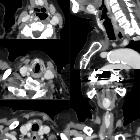Zungengrundstruma







A lingual thyroid is a specific type of ectopic thyroid and results from the lack of normal caudal migration of the thyroid gland.
NB: Location at the base of the tongue aside, the information in this article can relate to any ectopic thyroid tissue.
Epidemiology
The condition is congenital and there is a female predilection .
Clinical presentation
Many patients are asymptomatic and the diagnosis is made incidentally either as a result of imaging the tongue or attempting to image the thyroid and noting that it is absent.
In symptomatic patients the lingual mass may result in dysphagia, bleeding from mucosal ulceration, or even airway obstruction (more common in infants) .
Direct examination may reveal a nodular red mass of variable size, ranging from a few millimeters to 3-4 cm .
Pathology
A lingual thyroid results from failure of the normal caudal migration of the thyroid from the foramen cecum down to its normal location anterior to the larynx and upper trachea. Thyroid tissue may be found anywhere along the course of the thyroglossal duct, however, complete arrest with thyroid tissue located at the base of the tongue is most common and represents 90% of all cases of ectopic thyroid . Microscopic deposits of thyroid tissue along its route of descent have been identified in up to 10% of the population, representing small amounts of tissue being 'left behind' during normal development .
The thyroid tissue is normal histologically and functionally.
Markers
Thyroid function tests are either normal (majority of patients) or demonstrate variable states of hypothyroidism (up to a third of patients) .
Radiographic features
Ultrasound
Ultrasound is only of use in demonstrating absent thyroid tissue in the normal location, which is the case in the majority of cases . Only occasionally do patients have thyroid tissue both at the tongue base and elsewhere in the neck.
CT
CT demonstrates a hyperdense soft tissue mass, of the same attenuation as normal thyroid tissue. It is hyperdense on account of the normal accumulation of iodine within the gland .
Following contrast administration, the entire gland demonstrates prominent homogeneous enhancement (identical to the normal thyroid gland). There are occasional case reports of inhomogeneous contrast enhancement .
MRI
Usually seen as a well-defined mass with no invasive features.
Signal characteristics
- T1: iso to hyperintense to muscle
- T2: can vary from hypo to iso to hyperintense to muscle
- T1C+ (Gd): homogeneous strong contrast enhancement
Nuclear medicine
A technetium or iodine thyroid scan confirms the diagnosis and will also identify the presence of any thyroid tissue elsewhere in the neck.
Treatment and prognosis
Often no treatment is required. In cases where surgical excision is being contemplated, it is essential to establish if there is any normal thyroid tissue elsewhere (usually not the case) as removal of the lingual thyroid will in most cases render the patient profoundly hypothyroid .
Carcinoma of a lingual thyroid has been reported but is very rare, and presumed to be no higher in prevalence than of the normal thyroid.
Differential diagnosis
A general differential for a posterior midline neck mass includes :
- lingual tonsil
- thyroglossal duct cyst
- malignancy
- hemangioma
- dermoid
Siehe auch:
- Ductus thyreoglossus Zyste
- Foramen caecum linguae
- ektopes Schilddrüsengewebe
- Ductus thyreoglossus
- Tumoren des Zungengrunds
- dermoid
und weiter:

 Assoziationen und Differentialdiagnosen zu Zungengrundstruma:
Assoziationen und Differentialdiagnosen zu Zungengrundstruma:




